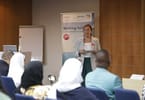Arusha, Tanzania ((eTN) – Ugandan President Yoweri Museveni is pushing for the East African region to embrace industrial revolution for the bloc to fly its population from the state of dire poverty, to a promised land of “riches and prosperity.”
According to Museveni, an embracement of “industrial revolution” is a lasting solution for the EAC bloc economic prosperity in modern days.
Addressing the fifth meeting of the second East African Legislative Assembly (EALA) in Arusha on Wednesday, Museveni, who is also a chairman of EAC Summit, said, “Agriculture alone, moreover subsistence agriculture, cannot cater for the employment needs of the 120 million East Africans, cannot earn enough foreign currency and cannot generate enough taxes.”
He further said as the region heading towards federation, all member states, at the level, work to bring in and facilitate more and more investors.
“We must combat all the negative anti-investor attitudes and practices: corruption, indifference to their needs, delays, etc. As each of our economies grows, East Africa will be stronger,” Museveni noted.
The EAC summit boss, back home in Uganda popularly known as “Mr. Vision,” was optimistic that the EAC is deepening its integration process.
President Museveni cited the ongoing process towards the establishment of the Common Market and the enlargement of the community, with the recent admission of Rwanda and Burundi as clear evidence. “Today, the trading bloc embraces a strong and large market of a combined population of 120 million people, has a land area of 1.8 million sq. kilometers with a combined GDP of US$ 41 billion,” he explained.
Museveni, however, noted that although the size of the EAC economy is still embarrassingly small, compared to other economies of the World with comparable populations, the potential is great.
He said he believes that the political integration of EAC, in the form of a federation, would accelerate the process of industrialization and modernization because of the bigger market being a more attractive investment destination and more clout in trade negotiations with other strong countries or blocs such as the USA, China, India, Russia and European Union.
“It is the factor of size that helped India and China to frog-leap in terms of development and social transformation,” Museveni said, stressing that it is imperative that the political strata and other elements of the elite wake up to the need for economic and social transformation so that the labor force shifts from agriculture to industry and services.
There were, however, some divergences of opinion on the timing of such a Federation. The samples showed that the populations of Kenya and Uganda, overwhelmingly, supported both the Federation and the fast-tracking as recommended by the Amos Wako Committee.
The population sampled in Tanzania, on the other hand, overwhelmingly bought the idea of the Political Federation of EAC, but did not support the integration timetable as recommended by the Wako’s Committee.
There were also concerns expressed about issues like land and natural resources in relation to this political integration.
The EAC Authority decided to maintain a united position on this matter by directing for the fast-tracking of the Common Market.
According to the agreed framework of the EAC Treaty, the entry point of EAC integration was the establishment of the customs union, which despite long delays occasioned by intermittent haggling and backpedaling by the bureaucrats, got off to a start in January 2005.
That key stage would then usher in the Common Market come 2010, the roadmap shows. A Monetary Union would then follow come 2012 before the people of East Africa can toast to the birth of a super-state in the name of a political federation.
Negotiations on EAC Common Market commenced on July 1, 2006 and are expected to come to a close in December 2008 with the signing of the Common Market protocol, if everything goes according to plan.
The protocol is expected to be ratified by June 2009 and the Common Market launched in January 2010 followed by monetary union in 2012.
The EAC is the regional intergovernmental organization of Kenya, Uganda, Tanzania, Rwanda and Burundi, with combined population of 120 million people, land area of 1.85 million sq kilometers and a combined Gross Domestic Product of $41 billion.
The EAC was brought into being by the treaty for Establishment of the EAC, which was signed on 30th November 1999. The treaty entered into force on 7th July 2000 following its ratification by the original three partner States-Kenya, Uganda and Tanzania.
Rwanda and Burundi acceded to the EAC Treaty on 18th June 2007 and became full members of the Community with effect from 1st July 2007.
Historically, the EA is credited as one of the longest experiences in regional integration. As early as 1900, Kenya and Uganda operated a Customs Union, which was later joined by Tanzania, the then Tanganyika, in 1922.
More elaborate regional integration arrangements in EA have included the East African High Commission way back in 1948-1961, the East African Common Services Organization in 1961-1967 and the former EAC which lasted from 1967 until its collapse in 1977.
The collapse of the former EAC was widely regretted and a major blow in many ways to the region.
Among the reasons cited for the collapse of the Community were structural problems which impinged upon the management of the common services, inadequate involvement of the people in the decision making processes, lack of compensatory mechanisms for addressing inequalities in the sharing of the costs and benefits of integration, ideological differences, vested interests and lack of vision on the part of some leaders.






















